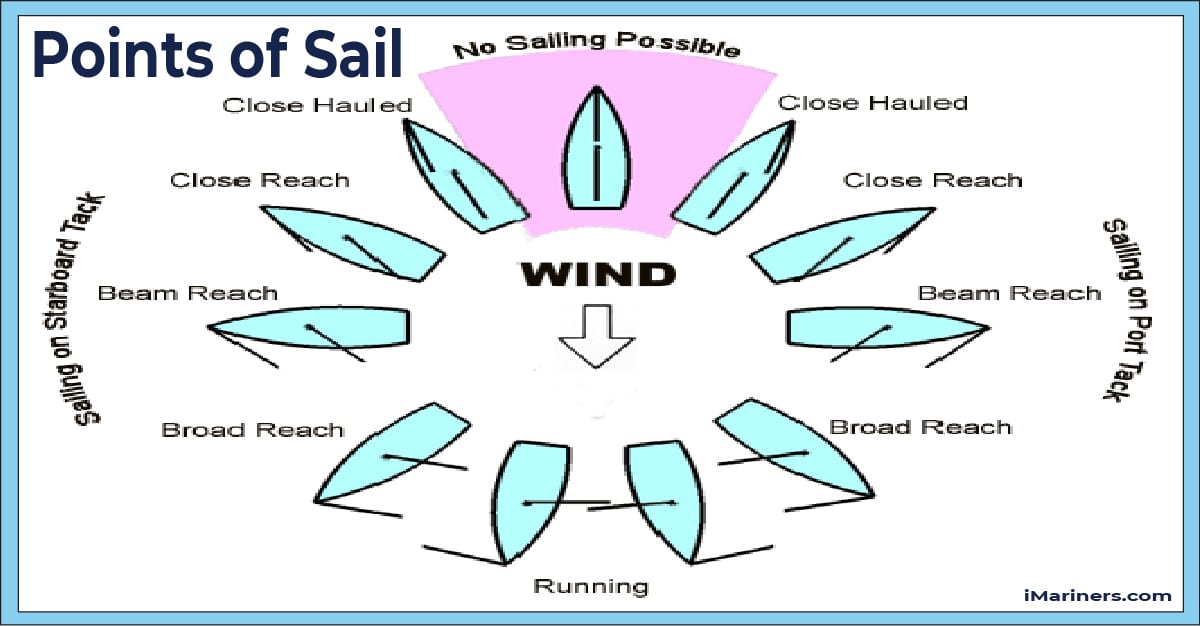A student asked me once: “Why do we have to learn the points of sail”? I struggled to find an answer at the time. With power boating there would be no need to learn points of sail. If we want to use the wind, instead of an engine, as our power source we will do well to learn the effects of wind on the sails and how to most efficiently use this power freely supplied by nature.

The wind changes direction and speed, the waves may be high or low, we may change our choice of destination; All of these impact the way the boat sails and handles. We harness the power of the wind with our sails, which must be adjusted, in order to create maximum advantage in varying conditions.
Adjusting (trimming) the sails is necessary to keep air flowing over the sail to provide power to move the boat. When a sail is pointed directly into the wind (imagine a flag flying) it only shakes about (luffing) and provides no driving force. Now take the after end of the sail (flag) and pull it sideways so it intersects the wind at an angle. If you were holding a flag in the wind you will now feel a force pulling against your hand. In a sailboat this force is harnessed into forward drive.
It’s important to understand a sailboat cannot sail directly into the wind. Before the late 1800s, when square riggers abounded, most ships could only sail ‘off’ the wind; That is, with the wind coming from behind. With the advent of the modern sailing rig, sailboats can now make way upwind but not straight into the wind. Interestingly, the fastest point of sail for most sailboats now is a close reach which takes us significantly upwind. And, for most modern sailboats, especially catamarans, sailing straight downwind on a run is one of the slowest ways to sail.
Boat speed is important. If the boat is not moving through the water the rudder will be useless. There is almost always enough wind to be able to sail at some speed, often it’s a matter of adjusting course and our point of sail.
Points of sail are defined by the angle of the wind coming over the boat relative to the bow. Looking straight ahead at the bow would be looking towards the top of the clock or, 12 o’clock.
Running. This puts us directly downwind with the sails let out at right angles to the centerline of the boat. The wind is at a relative bearing of 6 o’clock. We want to expose as much sail area as possible. Sail trim is not critical, small adjustments don’t make much difference in our boat speed. Note: The standing rigging on most boats will not allow the mainsail to eased far enough out. That’s ok, let it out to the point just before the sail touches any rigging (so as to prevent chafe) then tension the boom vang to bring the boom down.
Broad Reach. Here the wind is over one of our back shoulders or at a relative bearing of about 4 o’clock or 8 o’clock. We may adjust the sails but sail trim is not critical. Just as in running above we probably won’t be able to let the mainsail out beyond just where it starts to touch the rigging.
Beam Reach. Now the wind is coming across the boat at a right angle to the centerline, the relative bearing would be 3 o’clock or 9 o’clock. In order to make the sails most efficient we adjust (trim) them for maximum boat speed.
Close Reach. Now, the wind is coming from ahead of the boat with a relative bearing of 2 o’clock or 10 o’clock. The fastest point of sail for most boats. Sail trim is critical for our boat speed. Telltales on the sails will tell us how to trim. The basic idea is to let the sails out until they luff (flap) then bring them in just to the point on no longer luffing.
Close Hauled (or Beating). This is defined as the closest to the wind we can efficiently sail and is usually a relative bearing of 1 o’clock or 11 o’clock. On this point of sail the sails are brought in as close to the centerline of the boat as possible. Here, we will be making small changes to our course to fill the sails since we already have them trimmed in all the way.
When the wind is coming over the starboard side (boom on port) of the boat we are on a starboard tack. Likewise, when the wind is coming over the port side (boom now on starboard) we are on port tack. This is important to know because the rights of way for sailboats hinge on which tack each boat is on. To learn more about rights of way between boats go to Avoiding Collisions.
When sailing we are usually headed towards some sort of destination. Pointing the boat towards our destination would be the first step followed by adjusting the sails to allow us to maintain good boat speed in that direction. Often times this is all we have to do. If, however, our destination lies directly upwind we will have to sail close hauled on one side of the wind then change tacks to the other close hauled side. Changing tacks by putting the bow of the boat through the eye of the wind is called tacking.
The above diagram gives a rough idea of how sails should be trimmed for any point of sail. We are looking for smooth air flow over both sides of the sail with no luffing. When we have that, our sails are properly trimmed. We often employ telltales to help us determine not only the wind direction but also proper trim.
